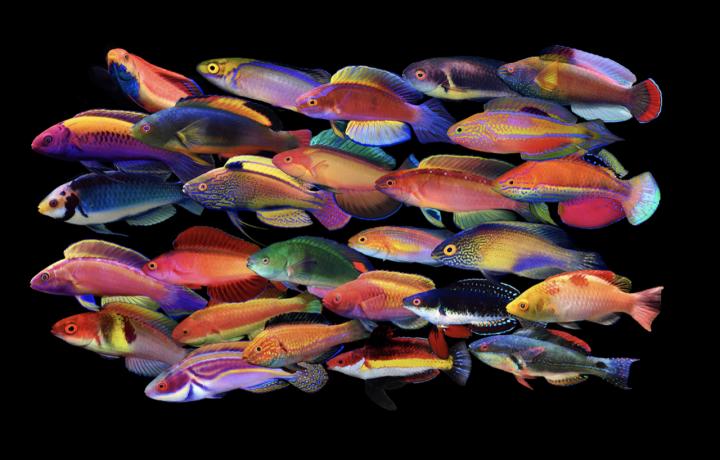Coral reef fish diverged in ‘evolutionary arms race’ during last ice age

Credit: Yi-Kai Tea.
With their exuberant colours, fiery personalities and captivating courtship displays, the fairy wrasses are one of the most beloved coral reef fish. Despite this, the evolutionary history of its genus was not well understood – until now.
Fairy wrasses diverged in form and colour after repeated sea level rises and falls during the last ice age, finds a new study. Published in top journal Systematic Biology, it employed a novel genome-wide dataset to make this discovery.
Lead author, ichthyologist and PhD candidate at the University of Sydney, Mr Yi-Kai (Kai) Tea, says that the fish’s divergence occurred rapidly and over a short amount of time.
“Although the fairy wrasses split from their most common ancestor some 12 million years ago, it was only within the last 2-5 million years ago that much of their divergences took place, in the Pliocene/Pleistocene epoch,” said Mr Tea, a researcher in the School of Life and Environmental Sciences.
“They developed distinct colours and forms in a sort of evolutionary arms race, putting on dazzling displays in an effort to court females and chase off rival males. Also, sea level changes caused groups to become isolated, and therefore evolve separately. The repeated rise and fall of sea levels acted like a ‘species pump’, propelling fish into the Indian Ocean and even as far as the Red Sea. Most of this movement, however, occurred in the Pacific Ocean, in particular, around the Indo-Australian Archipelago.”
Mr Tea completed the work under the supervision of Professors of Molecular Evolution, Simon Ho and Nathan Lo.
Decoding fish DNA
Despite the vast variation in colour and form, many species of fairy wrasses have highly conserved, or similar, regions of their genome. This poses a challenge in trying to reconstruct their evolutionary history.
The current study used an approach that had not been previously attempted on fairy wrasses: by combining genome-wide ultra-conserved elements with mitochondrial DNA, the researchers reconstructed a robust evolutionary tree. Using that, they began to tease apart the reason behind the fish’s diversification.
Do a little dance, make a little love
In addition to sea level fluctuations, male fairy wrasses (as with many animals, the more colourful sex) developed their bright colours and individual forms to court females.
“They do a little dance, and they are capable of changing colours, sometimes temporarily flashing bright, iridescent colours. They also do this to ward off rival males,” said Mr Tea. “In a reef where multiple species often occur, there is increased pressure for males to attract not only a female’s attention, but also the female of the correct species.”
“We have only just begun scratching the surface of this exciting group, and more work still needs to be done in order to fully understand the drivers of species diversification,” he continued.
That work, and the present study, might be germane to reef conservation and management, too. For example, the finless ‘mutant wrasse’, an Australian endemic species restricted to a narrow distribution of reefs in far northwest Western Australia, is listed as vulnerable on the International Union for Conservation of Nature Red List of threatened species. The species has been placed in its own genus, with a single species. However, Mr Tea’s study finds strong evidence that this species is simply a derived fairy wrasse, and that its loss of fins likely resulted from it being ‘bottlenecked’ in a narrow area.
###
Fairy wrasse facts
- Today, there are 61 fairy wrasse species, with new species continually being discovered.
- Fairy wrasses are petite – they grow no larger than 15cm in length.
- They live in large groups in rubble reefs (dead coral and rocks), next to coral cover, at depths of 10 to 250 metres.
- Males are more colourful, larger, and often sport more ornamented fins than females (this is known as ‘sexual dimorphism’).
- Fairy wrasses are sequential hermaphrodites, meaning that females are capable of changing into fully functional males.
- Fairy wrasses were discovered in the mid 1800s, yet scientists only began to investigate their origins and evolutionary relationships in the last few decades.
Media Contact
Loren Smith
[email protected]
Related Journal Article
http://dx.




